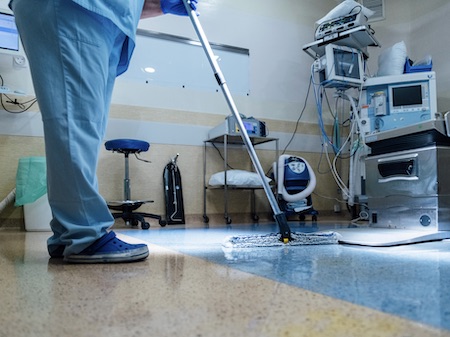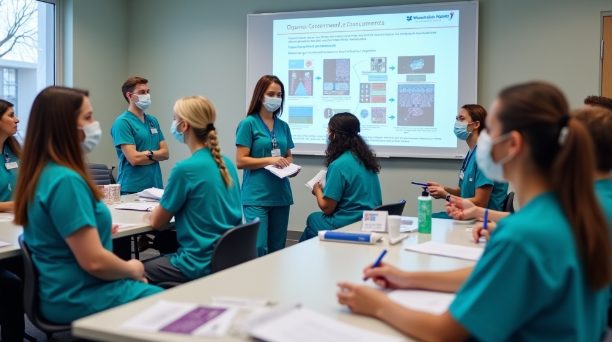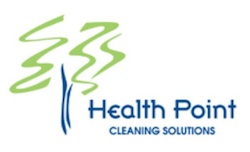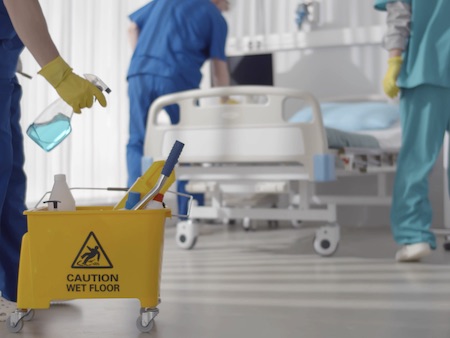Medical waste management is about safely handling waste from healthcare facilities. This waste can include items like used needles, bandages, and other materials that may be harmful if not managed properly. It is crucial for protecting both people and the environment.
Table of Contents
Key takeaways
- Medical waste management includes sharp objects and soiled items.
- Proper disposal is vital for public health and safety.
- Local regulations guide how medical waste is handled in Minneapolis.
- Healthcare facilities must train staff on safe waste management.
- Community awareness can help reduce risks.
For more detailed insights into healthcare sanitation practices, visit our page on maintaining cleanliness in healthcare environments. We provide valuable information on best practices for maintaining a clean and safe healthcare environment, including tips for implementing proper infection control protocols. Our page offers a comprehensive overview of the importance of following these protocols, as well as practical strategies for ensuring adherence to guidelines and regulations. By following our guidelines, healthcare facilities can minimize the risk of healthcare-associated infections and promote a healthier, safer environment for both patients and staff.
What is Medical Waste Management?

Medical waste management is any waste that comes from healthcare activities. This can be from hospitals, clinics, labs, and even dentists’ offices. The waste can be hazardous to health. Common types of medical waste include:
- Sharps: Needles, scalpels, and other sharp items.
- Pathological waste: Human tissues, organs, and body parts.
- Infectious waste: Waste that can spread infections, like used bandages.
- Chemical waste: Unused or expired medications and chemicals.
Types of Medical waste management and their characteristics
| Type of Waste | Description | Hazards |
|---|---|---|
| Sharps | Needles and broken glass | Cuts, infections |
| Pathological waste | Tissues and organs | Biohazards, disease transmission |
| Infectious waste | Contaminated materials | Spread of infections |
| Chemical waste | Pharmaceutical products and hazardous chemicals | Environmental contamination |
Why is Medical Waste Management Important?
Managing medical waste is important for a few reasons:
- Health risks: Improper disposal can spread disease. Sharp objects can cause cuts and infections.
- Environmental safety: Chemicals and biological materials can harm our environment. They can contaminate soil and water.
- Legal requirements: Some laws dictate how medical waste must be handled. Failing to comply can lead to fines and other penalties.
Regulations for Medical Waste Management in Minnesota

In Minneapolis, laws guide how medical waste should be managed. The Minnesota Pollution Control Agency (MPCA) sets rules for safe disposal. These rules help ensure that waste is handled properly.
Types of regulations
- Classification of waste: Not all waste is treated the same. Medical waste must be identified and classified correctly.
- Packaging and labeling: Medical waste must be stored in special containers to prevent leaks and spills. Containers must be clearly labeled.
- Transport rules: When waste is moved, it must be done safely. Only trained personnel should handle it.
- Disposal methods: Waste can be incinerated, autoclaved, or treated in other ways to make it safe.
How is Medical Waste Management Treated?
Treating medical waste involves several steps. Here’s how it typically works:
Collection
Waste is collected at healthcare facilities. Staff must be trained to handle waste safely. They should know how to sort waste into the correct containers.
Storage
Once collected, waste is stored in a secure area. This area should be cool, dry, and away from the public. It must be locked to prevent unauthorized access.
Transport
Transporting medical waste to disposal sites must be done carefully. Vehicles must have proper equipment to keep waste secure.
Treatment
There are different ways to treat medical waste:
- Incineration: This burns the waste at high temperatures. It reduces waste volume and kills harmful pathogens.
- Autoclaving: This uses steam and pressure to sterilize waste. It is effective for many types of medical waste.
- Chemical treatment: Some waste can be treated with chemicals to neutralize harmful substances.
Disposal
After treatment, the waste can be disposed of safely. Incinerated waste turns to ash, which can be removed safely. Treated waste can often go to landfills.
Key Challenges in Medical Waste Treatment
- Inconsistent practices: Variability in treatment methods across facilities may lead to ineffective waste management.
- Equipment malfunctions: Failures in sterilization equipment can pose risks of contamination.
- Compliance issues: Facilities may struggle with meeting all regulatory requirements.
The Role of Healthcare Facilities
Healthcare facilities play a big part in managing medical waste. They must follow rules and ensure safe practices. Here are some key responsibilities:
Staff training
All staff should be trained on how to handle medical waste. This includes:
- How to sort waste: Knowing which items go where.
- Using protective gear: Wearing gloves, masks, and other equipment to stay safe.
- Recognizing hazards: Understanding the risks involved with different types of waste.
Developing a Medical Waste Management Plan
Each facility should have a waste management plan. This plan outlines how they will handle waste safely. It should include:
- Waste classification: How to identify different types of waste.
- Storage practices: Where and how waste will be stored.
- Disposal methods: How waste will be treated and disposed of.
Regular audits
Facilities should perform regular audits. This helps ensure that waste management practices are followed. It also identifies areas for improvement.
Community Awareness and Involvement
The community plays a role in medical waste management, too. By understanding the issues, residents can help keep themselves and the environment safe.
Educating the public
Public awareness campaigns can help teach people about the importance of proper waste disposal. Schools and community groups can host events to spread the word.
Safe disposal of personal medical waste
Residents may have medical waste at home, such as:
- Used needles: From diabetes or other medical conditions.
- Expired medications: Unused prescriptions that need to be disposed.
It is important to use safe disposal methods for these items. Many pharmacies offer take-back programs for unused medications. Residents should never throw needles in the regular trash. Instead, they should use special containers or drop-off sites.
Benefits of Proper Medical Waste Management
Managing medical waste well has many benefits. Here are a few:
- Protects health: Reduces the risk of spreading infections and diseases.
- Safeguards the environment: Keeps harmful substances out of the ground and water.
- Enhances community trust: Shows that healthcare facilities care about safety.
- Improves compliance: Helps healthcare facilities meet legal requirements.
The Importance of Community Involvement
- Informed citizens can help reduce improper disposal.
- Community programs can facilitate safe disposal methods.
- Local partnerships can enhance awareness campaigns.
Common Challenges in Medical Waste Management
While managing medical waste is crucial, it comes with challenges. Here are some common issues:
Lack of training
Sometimes staff do not receive enough training. This can lead to mistakes in handling waste.
Costs
Proper waste management can be expensive. Smaller facilities may struggle to afford the necessary systems.
Regulations
Keeping up with changing regulations can be difficult. Facilities must stay informed to comply with laws.
Public perception
Some people may not understand the importance of medical waste management. This can lead to resistance to programs.
Innovations in Medical Waste Management
As technology advances, new solutions are emerging for medical waste management. Here are some exciting developments:
Advanced sterilization technologies
New methods are being developed to sterilize waste more effectively. Some use heat, while others use chemical processes.
Tracking systems
Some facilities are using technology to track waste from collection to disposal. This helps ensure that waste is handled properly at every stage.
Recycling initiatives
There is a growing focus on recycling medical materials. Some items, like plastics, can be recycled safely.
For more information on healthcare waste management strategies, explore our guide on optimizing waste disposal processes.
Conclusion
Medical waste management is essential for health and safety. In Minneapolis, strict regulations guide how this waste is handled. Healthcare facilities must train staff and develop waste management plans. The community also has a role in ensuring safety. By understanding the risks and knowing how to dispose of medical waste safely, everyone can help keep our environment clean and healthy.
Managing medical waste is not just a healthcare issue. It is a community issue. With awareness and action, we can all contribute to a safer future.
For professional assistance with medical waste management services, feel free to reach out to our team at Health Point Cleaning Solutions. Your health and safety are our top priorities.

